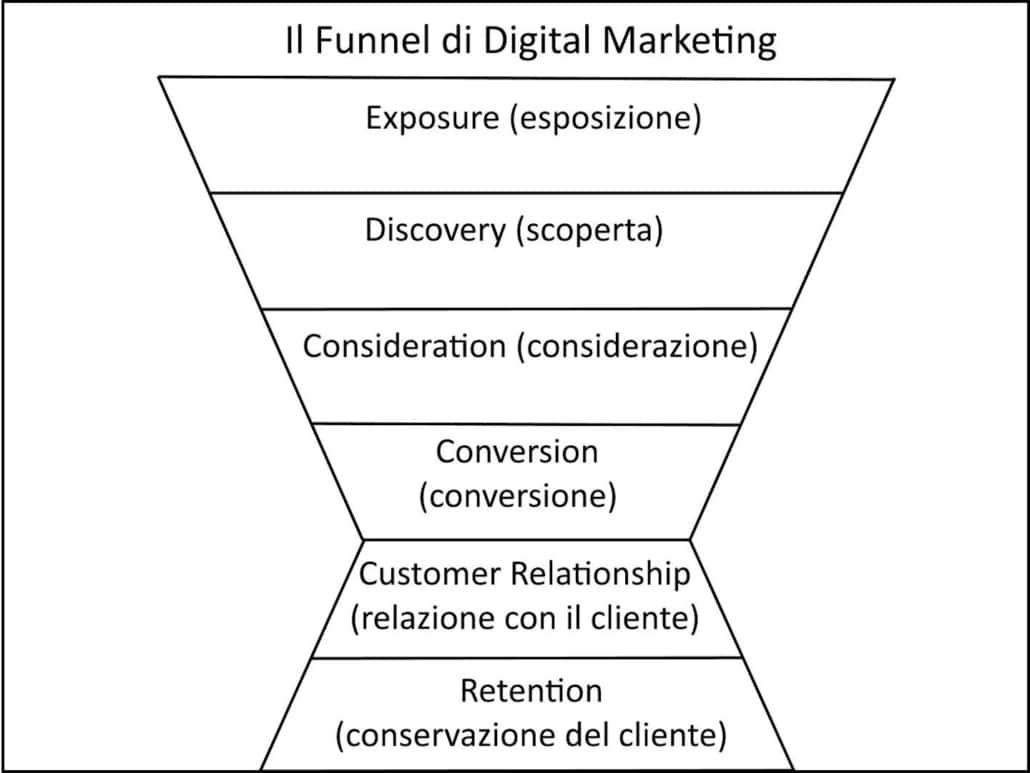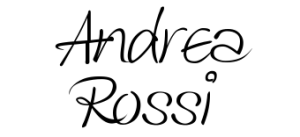Mastering the Digital Marketing Funnel for Business Success

The Digital Marketing funnel is a strategic model that represents the entire customer journey of tourists, from the moment they come into contact with the brand until they become customers and then loyal customers. It is called a funnel because it resembles a funnel that gradually narrows down (at least in the first part).
The concept is widely used by salespeople but has also become a fundamental resource for the success of marketing and communication efforts. There are numerous approaches to the funnel concept, and the model presented in this paragraph, proposed by Marketingprofs.com [marketingprofs.com, 2016], is divided into six stages (Fig. 1):
- Exposure
- Discovery
- Consideration
- Conversion
- Customer relationship
- Retention

Fig. 1 – The Digital Marketing Funnel, adapted by the Author from [marketingprofs.com, 2016]
First, we can divide the funnel into three sections [marketingprofs.com, 2016]:
- Top of the funnel (TOFU)
- Middle of the funnel (MOFU)
- Bottom of the funnel (BOFU)
- Top of the Funnel (TOFU): The top portion of the digital marketing funnel (exposure and discovery) represents the first interactions that tourists have with the brand. Today, these interactions can come from various directions. The most common are “organic” search results (i.e., non-advertising-related), but that’s not always the case. Therefore, the first step is to understand which channels people are using to discover our content.
- Middle of the Funnel (MOFU): In the middle of the funnel (consideration and conversion), interested potential customers (called leads) move from the initial interaction towards making a purchase or possibly making additional purchases based on their experience with our brand so far.
- Bottom of the Funnel (BOFU): The bottom of the funnel is where customer relationships are managed, focusing on customer care and satisfaction to generate new purchases from loyal customers.
Going into more detail about the stages [rockcontent.com, 2020]:
- Exposure: On average, there are about 75,000 searches per second on Google. This means it is necessary to be present and, more importantly, be visible within this channel. Therefore, we need to start our Content Marketing strategy (which we will see in Chapter 3) by strengthening our presence through Search Engine Optimization (SEO, which we will see in Chapter 4) techniques or even paid advertising on search engines. The important thing is for the user to enter a specific keyword (keyword), and our page appears among the top results. In this stage, the goal is to produce content that captures the attention of users, such as informative videos and infographics. Now is the time to attract as much qualified traffic as possible. On the blog, we should focus on materials targeted at people who are not familiar with our brand or on the fact that we can offer solutions to some of their problems. The formula for this step is simple: to increase exposure, the brand should work with topics that attract a large number of people. To do this, they can conduct research focused on a short-tail keyword with thousands of searches per month.
- Discovery: In this next step, the ideal is to focus on producing content that encourages users to become interested in our brand. After all, even though the previous stage means they already know our brand, we need to make them stay on our page to discover our products, services, and solutions. There is no point in bringing a user to our website if they have no interest in our brand. This will only increase the bounce rate of our site, which can even harm the exposure phase. The main goal of this stage is to turn the visitor into a lead (interested potential customer). And now the first challenge arises: offering material or content that encourages the user to provide their contact information by creating an account, for example, or asking users to take action (e.g., subscribing to a newsletter). The most suitable suggestion for this stage is to provide rich and informative content that presents offers aligned with the needs, desires, and passions of tourists.
- Consideration: Consumers are in a consideration stage when they are aware of our brand and know that we can provide offers aligned with the needs, desires, and passions of tourists. But we are not the only ones. Some competitors are also in the decision-making process. It is up to us, then, to provide materials that facilitate their decision-making process towards us. Therefore, the most suitable materials are those that explain the differentiators and advantages of our offer. In this stage, we already know a bit more about the leads (potential interested customers) and what they are looking for. Our content should present facts and information that demonstrate the superiority of our proposal. It can be helpful to present frequently asked questions (FAQs) that address the main issues or relevant evaluations from other customers. After all, there is nothing better than the opinion of someone who has already tried a specific product or service to make a decision. Investing in examples and concrete cases of experiences lived by other tourists, for example, is an excellent way to clarify any doubts they have about what we offer. The idea is to communicate everything necessary to confirm the superiority of our offer.
- Conversion: Now that we have showcased the pros of our offer, it is time to help potential customers make the decision. So, it’s time to focus on increasingly personalized content based on our goals, preferences, and challenges. It’s time to create personalized campaigns. With sponsored links, we can draw the user’s attention to a specific landing page, a special page on the website created and focused solely on converting users. In all communications, it is necessary to focus on the benefits and emotions that the tourist can experience with the help of our brand, while slightly neglecting the technical and informational aspects. The idea is for them to understand practically how what we offer is better than what our competitors offer and, therefore, make a purchase.
- Customer Relationship: With the conversion of leads into customers through the purchase, the next step is to get closer to our customers. It is essential to set aside brand advertisements and focus on providing tourists with the best ways to experience their time with us. This closer contact can become a source of great competitive advantage. For example, investing in an Email Marketing/Messenger Marketing strategy can further strengthen our relationship with the customer. This way, we can establish a direct channel with them, including all social contacts, and be available to resolve their doubts now that they know our brand and how we can provide them with an unforgettable experience.
- Retention: The work has been extensive, but it’s not over yet. It’s time to think about actions and content focused on the challenge of customer retention. In other words, we need to ensure that the consumer who already knows our brand and has purchased our product or service continues to make new transactions. Especially in the long term, this phase is crucial. In addition to continuing the production of content from the previous stage, it is essential to regularly monitor and analyze our communications with customers. A very efficient way to do this is by interviewing customers, perhaps by asking for a qualitative and quantitative evaluation to create case studies to be used in the previous stages.
Creating a Digital Marketing funnel for our business is, therefore, essential to develop increasingly accurate actions and generate an impact on our target audience.
References:
- [marketingprofs.com , 2016] marketingprofs.com, Matt Banner “Today’s Digital Marketing Funnel (and How to Optimize Your Conversions)” 22 march 2016, https://www.marketingprofs.com/articles/2016/29582/todays-digital-marketing-funnel-and-how-to-optimize-your-conversions ; retrieved 22.05.2023
- [Rossi A., 2022] Andrea Rossi “Comunicazione Digitale per il Turismo”, KPD, 2022
- [rockcontent.com, 2020] rockcontent.com, Rock Content Writer, 31 march 2020 “Digital Marketing funnel: what is, how to create one and what type of content work in each stage” https://rockcontent.com/blog/digital-marketing-funnel/ ; retrieved 22.05.2023
#DigitalMarketingFunnel #BusinessSuccess #MarketingStrategy #CustomerJourney #CustomerRetention #OnlineMarketing #MarketingTips #DigitalAdvertising #ContentMarketing #CustomerExperience

Leave a Reply
Want to join the discussion?Feel free to contribute!